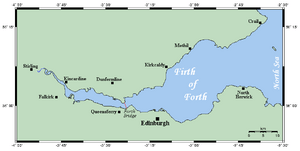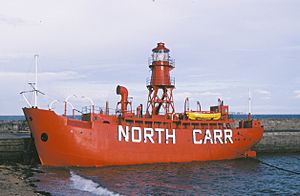North Carr facts for kids
The North Carr Reef is a group of rocks hidden mostly underwater. It's found northeast of Edinburgh, Scotland, right where the Firth of Forth meets the North Sea. This area is very busy with ships, so the reef has caused many shipwrecks over the years.
To help ships avoid the reef, a buoy was first placed there in 1809. Later, in 1821, a more permanent beacon was built by a famous engineer named Robert Stevenson. For many years, from 1877 to 1975, special lightships also helped guide ships. Today, the old beacon still stands, but the reef is mainly protected by the Fife Ness lighthouse on the nearby mainland.
Contents
What is the North Carr Reef?
The North Carr Reef stretches about 1.5 miles (2.4 km) from Fife Ness into the North Sea. It's made up of about fourteen sandstone rocks. These rocks are completely covered by water when the tide is high. Some of the rocks have interesting names like Englishman's Skelly and Mary's Skelly.
The word carr might come from a Gaelic word meaning the flesh of a seal or whale. Perhaps the rocks looked like the back of these animals, or maybe seals and whales were hunted there long ago.
History of the North Carr Reef
Many ships have been wrecked on the North Carr Reef. Some of these include the schooner Louise, the tanker Vildfugl, and the cargo steamer Einar Jarl.
The first buoy was put in place by the Northern Lighthouse Board in 1809. But winter storms often destroyed it. So, a more lasting structure, the North Carr Beacon, was started in 1813. This project was led by Robert Stevenson, who was well-known for building lighthouses. He had just finished the famous Bell Rock Lighthouse.
Building the beacon was very difficult. The rocks were barely visible even at low tide, so workers could only build for a few hours every two weeks. Stevenson first planned a 40-foot (12-meter) hollow tower with a bell. However, the foundations were very small and rocky. Parts of the structure were washed away by storms in 1815, 1816, and 1817. In 1817, the tower was almost finished when a storm knocked it down.
Because of these problems, the design was changed. They decided to build a pyramid-shaped structure made of cast iron columns with a ball on top. This new design was finished in 1821.
A lightship was placed near the beacon in 1887 to help even more. This ship had a bright light that could be seen for 11 miles (18 km). Two years later, a new lightship was built specifically for the Northern Lighthouse Board. This ship was later replaced in 1933 by another vessel. This lightship had a powerful electric light that flashed to warn ships.
During World War II, the lightship was moved for safety. In December 1959, a big storm caused the lightship to break free from its anchors. The crew of the Broughty Ferry lifeboat bravely tried to rescue the lightship's crew. The lightship crew managed to drop anchor near Kingsbarns and were rescued by helicopter. The lightship itself was eventually towed to safety.
In 1975, the lightship was replaced by a lighted buoy. At the same time, a new lighthouse was built at Fife Ness on the mainland. The old lightship was saved from being scrapped in 2010. A charity is now trying to raise money to restore it and turn it into an exhibition space.
Visiting the North Carr Reef
If you want to see the North Carr Reef, you can park at the Crail Golfing Society carpark. From there, you can follow a path that leads to the lighthouse and Coastguard Station. Remember, the rocks of the reef can only be seen when the tide is low.
It's a good idea to bring binoculars! You might be able to spot pods of dolphins from the shore, and sometimes even whales.
Images for kids




